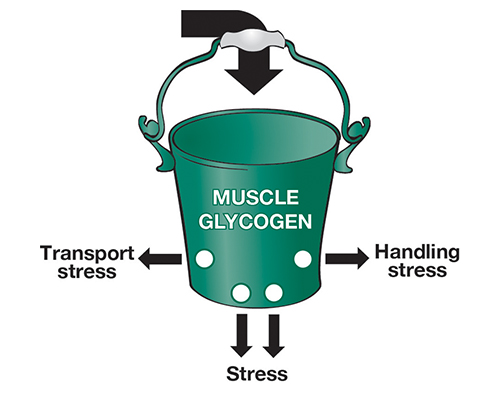True or False? Large Amounts of Glycogen Can Be Stored Through Eating Beef or Chicken.
Eating quality is a fundamental purchase driver for red meat consumers. Meeting these eating quality expectations and giving consumers confidence in their beef and sheepmeat purchases is the purpose of Meat Standards Commonwealth of australia (MSA).
MSA is a national beef and sheepmeat eating quality programme. It aims to accurately predict eating quality and ideal cooking methods for individual cuts. It is a paddock-to-plate system ensuring that all critical control points that touch eating quality along the supply chain are monitored and managed.
The main factors that affect beef eating quality are:
- Hump height - All breeds of cattle are eligible for MSA grading. Hump height is used as a direct predictor of eating quality in conjunction with hot standard carcase weight (HSCW) and sexual practice. Generally, as hump pinnacle increases, eating quality decreases.
- Maturity - Ossification is a measure of the physiological maturity of a carcase, that is, the procedure of cartilage turning to bone in the vertebrae. Every bit the ossification score increases, eating quality decreases.
- Fat coverage - An fifty-fifty coverage of subcutaneous (external) fatty on a carcase ensures an even chilling of all muscles and prevention of dehydration and toughening.
- Marbling - The fatty that is deposited betwixt individual muscle fibres and it has a very positive consequence on the eating quality of some cuts only is only one of many factors affecting eating quality. This can exist attributed to its outcome on juiciness and flavour of beefiness when cooked.
- Hormonal Growth Promotants (HGPS) - They play a vital role in delivering productivity gains, but they can have an adverse issue on eating quality. This effect varies across different muscles.
- Ultimate pH –Loftier pH meat (defined as higher up pH 5.70) is undesirable and has the following features:
- Dark purple color. This is known as dark-cutting meat.
- Coarse texture.
- High water holding capacity and then less juicy when cooked.
- Reduced shelf life due to bacterial growth in high pH atmospheric condition.
- Cooking inconsistencies.
The eating quality performance of an animal is influenced past multiple on-farm factors. Feeding and finishing, together with aspects of creature direction such as genetics, animate being health and treatment, are critical links in the eating quality chain. It is of import to exist mindful of how feeding and finishing influence eating quality, and implement systems that optimise eating quality potential.
For this reason Meat Standards Commonwealth of australia (MSA) has produced beef and sheep supply guidelines to optimise the eating quality potential of the beast.
Registering as an MSA producer provides you with:
- Admission to the carcase feedback/benchmarking functions in myMSA.
- Market place access into supply chains that require MSA registration.
- Ability to maximise any potential premiums that may be attached to supply chains.
- Confidence in the stop production and the integrity of the supply chain.
- Access to resources, training and the latest information on MSA and eating quality.
Additional factors that impact eating quality
An important element contributing to anticipated eating quality performance is the on-farm or feedlot creature management prior to slaughter.
The long period of care and investment in producing an animate being with loftier eating quality potential is most at risk in the two weeks pre-slaughter, and the first few hours mail service-slaughter. The best carcase can exist reduced to a low quality, unacceptable product by inappropriate action in this period. The damage is caused by changes in muscle glycogen (blood sugar) levels.
Glycogen and pH
Glycogen, in essence, is the energy reserve of the muscle. The glycogen level in muscle is increased by feeding (a process taking days) and apace reduced by stress (which may just take minutes) or activity in the live animal.
Every creature has a sure amount of free energy contained in its muscles in the form of glycogen. At the betoken of slaughter, the glycogen in muscle is converted to lactic acid that steadily decreases the pH of the muscle, largely determining the ultimate eating quality result.
The more glycogen there is in the muscle, the more lactic acid will be produced and the lower the ultimate pH will exist. MSA requires ultimate pH to exist 5.70 or less.
If the glycogen in the live muscle falls below the adequate threshold the resulting meat will have a loftier pH. Lower glycogen levels can be the result of poor nutrition or other factors such as poor handling and excessive stress.
Meat with an ultimate pH above 5.seventy is classified as night cutting. Characterised by a darker colour, coarse texture, inferior flavour and reduced shelf life, dark cutting meat can be associated with reduced tenderness.
Minimising take chances
The most effective fashion to minimise the risk of high pH is to ensure high levels of muscle glycogen at the point of slaughter. Appropriate feeding and minimising stress in the pb up to slaughter volition optimise the amount of stored glycogen.
Feeding and finishing
Ensuring animals are on a rising plane of nutrition, particularly in the 30 days prior to processing, is the best way to optimise glycogen levels and eating quality potential.
Well-planned feeding and finishing systems enable creature condition to be monitored for turn off that meets precise market specifications.
The glycogen bucket
The glycogen relationship can best exist illustrated through the 'glycogen bucket' below.
Nutrition provided for the animal is the energy pouring into the bucket, which builds musculus glycogen. The holes in the bucket correspond the factors that utilise up muscle glycogen such every bit exercise or stress. These factors volition always be nowadays in some form, only information technology'south of import to minimise their impact. That is, to keep the 'holes' in the bucket as pocket-size as possible.

Source: https://www.mla.com.au/research-and-development/meat-standards-australia/factors-affecting-eating-quality/
0 Response to "True or False? Large Amounts of Glycogen Can Be Stored Through Eating Beef or Chicken."
Post a Comment